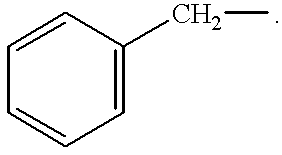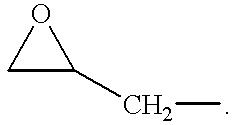Pigment dispersions containing dispersants having pendent hydrophobic polymeric segments prepared by controlled radical polymerization
a control method and pigment dispersant technology, applied in the field of pigment dispersions, can solve the problems of poor stability, non-living or free radical polymerization methods to synthesize pigment dispersants, and poor stability of aqueous pigment dispersions containing pigment dispersants prepared by conventional non-living radical polymerization methods, etc., and achieves the effect of improving the stability and reducing the number of polymerization steps
- Summary
- Abstract
- Description
- Claims
- Application Information
AI Technical Summary
Benefits of technology
Problems solved by technology
Method used
Image
Examples
example a
A prepolymer having a radically polymerizable group was prepared by controlled radical polymerization from the ingredients enumerated in Table A. The prepolymer of Example A was modified as described in Example B.
TABLE A Ingredients Parts by weight Charge 1 toluene 400 magnesium silicate (a) 30 Charge 2 2,2'-dipyridyl 4.7 copper powder (b) 3.8 p-toluenesulfonyl chloride 63 toluene 50 Charge 3 glycidyl methacrylate monomer 171 Charge 4 isobutyl methacrylate monomer 512 toluene 100 Charge 5 allyl methacrylate monomer 95 toluene 70 Charge 6 magnesium silicate (a) 30 (a) MAGNESOL synthetic magnesium silicate obtained commercially from The Dallas Group of America. (b) The copper powder had an average particle size of 25 microns, a density of 1 gram / cm.sup.3, and was obtained commercially from OMG Americas.
(b) The copper powder had an average particle size of 25 microns, a density of 1 gram / cm.sup.3, and was obtained commercially from OMG Americas.
Charge 1 was added to a 2 liter 4-necked ...
example b
The prepolymer of Example A was modified by reaction with para-nitrobenzoic acid using the ingredients as enumerated in Table B. The modified prepolymer of Example B was then used to prepare a pigment dispersant according to the present invention as described in Example C.
TABLE B Ingredients Parts by weight prepolymer of Example A (c) 910 para-nitrobenzoic acid 120 ethyltriphenylphosphonium iodide catalyst 1.5 (c) Having a resin solids content of 69 percent by weight, based on total weight, in methyl 2-hydroxypropyl ether.
The ingredients listed in Table B were added to a 1 liter round bottom flask equipped with a motor driven stainless steel stir blade, water cooled reflux condenser, and a heating mantle and thermometer connected through a temperature feedback control device. The contents of the flask were heated to and held at 110.degree. C. for 11 hours under a dry nitrogen sweep. Upon completion of the 11 hour hold, the contents of the flask were cooled to room temperature and tr...
example c
A pigment dispersant useful in the pigment dispersions of the present invention was prepared from the copolymerization of the modified prepolymer of Example B with an ethoxylated methacrylate monomer using the ingredients as enumerated in Table C.
TABLE C Ingredients Parts by weight Charge 1 methyl isobutyl ketone 50 MPEG 550 MA monomer (d) 694 t-amylperoxy(2-ethylhexanoate) (e) 26 Charge 2 modified prepolymer of Example B (f) 120 methyl isobutyl ketone 250 Charge 3 t-amylperoxy(2-ethylhexanoate) (e) 2.6 methyl isobutyl ketone 30 (d) MPEG 550 MA monomer is a methoxy poly(ethylene glycol) methacrylate monomer from Sartomer Company, Inc. (e) LUPEROX .RTM. 575 free radical initiator obtained commercially from Elf Atochem. (f) Having a resin solids content of 68.7 percent by weight, based on total weight, in methyl 2-hydroxypropyl ether.
Charge 1 was added to an addition funnel. Charge 2 was added to a 2 liter 4-necked flask equipped with a motor driven stainless steel stir blade, water c...
PUM
| Property | Measurement | Unit |
|---|---|---|
| Fraction | aaaaa | aaaaa |
| Fraction | aaaaa | aaaaa |
| Fraction | aaaaa | aaaaa |
Abstract
Description
Claims
Application Information
 Login to View More
Login to View More - R&D
- Intellectual Property
- Life Sciences
- Materials
- Tech Scout
- Unparalleled Data Quality
- Higher Quality Content
- 60% Fewer Hallucinations
Browse by: Latest US Patents, China's latest patents, Technical Efficacy Thesaurus, Application Domain, Technology Topic, Popular Technical Reports.
© 2025 PatSnap. All rights reserved.Legal|Privacy policy|Modern Slavery Act Transparency Statement|Sitemap|About US| Contact US: help@patsnap.com



